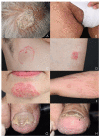Cutaneous Fungal Infections Caused by Dermatophytes and Non-Dermatophytes: An Updated Comprehensive Review of Epidemiology, Clinical Presentations, and Diagnostic Testing
- PMID: 37367605
- PMCID: PMC10302839
- DOI: 10.3390/jof9060669
Cutaneous Fungal Infections Caused by Dermatophytes and Non-Dermatophytes: An Updated Comprehensive Review of Epidemiology, Clinical Presentations, and Diagnostic Testing
Abstract
Cutaneous fungal infection of the skin and nails poses a significant global public health challenge. Dermatophyte infection, mainly caused by Trichophyton spp., is the primary pathogenic agent responsible for skin, hair, and nail infections worldwide. The epidemiology of these infections varies depending on the geographic location and specific population. However, epidemiological pattern changes have occurred over the past decade. The widespread availability of antimicrobials has led to an increased risk of promoting resistant strains through inappropriate treatment. The escalating prevalence of resistant Trichophyton spp. infections in the past decade has raised serious healthcare concerns on a global scale. Non-dermatophyte infections, on the other hand, present even greater challenges in terms of treatment due to the high failure rate of antifungal therapy. These organisms primarily target the nails, feet, and hands. The diagnosis of cutaneous fungal infections relies on clinical presentation, laboratory investigations, and other ancillary tools available in an outpatient care setting. This review aims to present an updated and comprehensive analysis of the epidemiology, clinical manifestations, and diagnostic testing methods for cutaneous fungal infections caused by dermatophytes and non-dermatophytes. An accurate diagnosis is crucial for effective management and minimizing the risk of antifungal resistance.
Keywords: clinical; cutaneous fungal infection; dermatophyte; diagnosis; epidemiology; microsporum; non-dermatophyte; onychomycosis; tinea; trichophyton.
Conflict of interest statement
The authors declare no conflict of interest.
Figures




References
-
- Verma S.B., Panda S., Nenoff P., Singal A., Rudramuruthy S.M., Uhrlass S., Das S., Bisherwal K., Shaw D., Vasani R. The unprecedented epidemic-like scenario of dermatophytosis in India: I. Epidemiology, risk factors and clinical features. Indian J. Dermatol. Venereol. Leprol. 2021;87:154–175. doi: 10.25259/IJDVL_301_20. - DOI - PubMed
-
- Emmons C.W. Dermatophytes: Natural grouping based on the form of the spores and accessory organs. Arch. Derm. Syphilol. 1934;30:337–362. doi: 10.1001/archderm.1934.01460150003001. - DOI
Publication types
LinkOut - more resources
Full Text Sources
Miscellaneous

